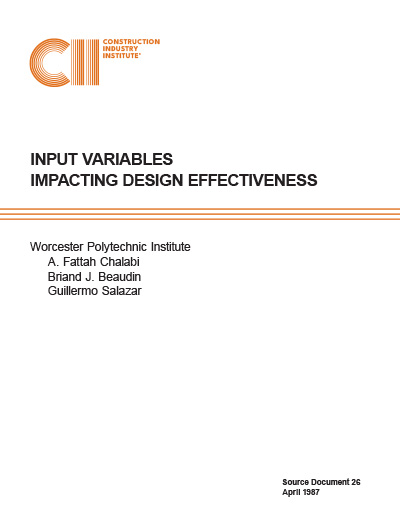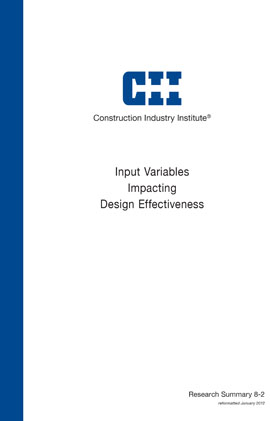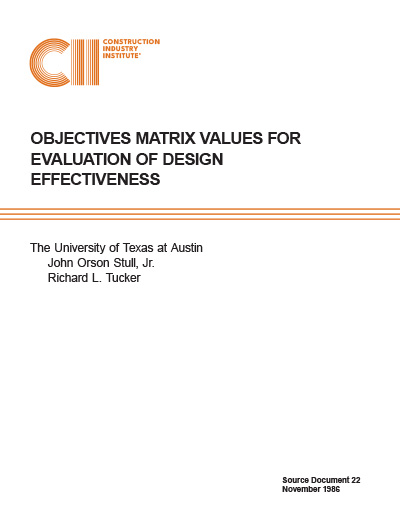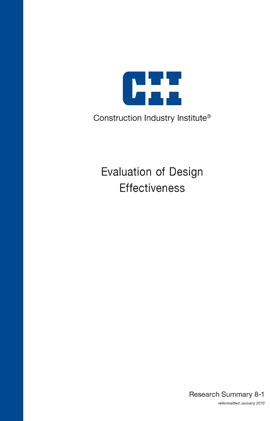
Input Variables Impacting Design Effectiveness
The Role of Input Variables in Design
Design is a complex and creative process consisting of the reconciliation of competing objectives and constraints. Design effectiveness is one of the major determinants of project success. In most projects decisions made in the early project phases, including scope definition, selection of the designer, and basic engineering have the highest influence on the project. These decisions and other constraints or existing conditions form input variables to design.
To understand the origin of input variables and how they influence design effectiveness, it is necessary to first examine the project execution steps. For this purpose, a project may be divided into seven phases: 1) The Conceptual/Preliminary analysis, 2) Project Initiation and Organization, 3) Basic Engineering, 4) Detail Planning, 5) Production Engineering and Procurement, 6) Construction, and 7) Commissioning. Input variables occur in the first five phases, but those having a major influence occur primarily in Phase I and Phase II. In these phases the owner is the principal actor. The designer begins to have a major role in the second phase. In some cases, key vendors or a constructor may participate as well.
The Conceptual Analysis should establish a basis for decisions on whether to proceed with a project, and define the initial scope and baseline of the project. The Preliminary Analysis, which should have the involvement of key owner personnel and/or a consultant, normally results in a basic charter, global objectives, and preliminary design data as a minimum. After the Agreement (contract for design services) is developed a project team, headed by a project manager, is selected to initiate the project. While the make-up of the project team may vary somewhat during the execution of the project it is important that the key members of the team remain with the project until their services are no longer required.
If the owner does not have in-house design capabilities he must select a designer. The designer’s effort may begin with process design if the owner has not supplied the process. Although the type of contract influences the level of owner participation, the design effort cannot be sustained, as planned, without the owner’s timely release of project data, reviews, comments, and approvals. The project Initiation Phase should result in sufficient data to commence design. This may include site data, process description, preliminary engineering plans and schedules, owner’s specifications, critical equipment and materials, preliminary costs, starter schedule, and procurement plans.
Basic Engineering is the last phase in which the primary input variables are decided for the project. At the end of this phase the design work to allow the initiation of planning and the requisition of equipment is completed. Sufficient analysis and layout occurs during the Detailed Planning Phase to determine for each discipline their scope of work and interface with other groups.
Before Production Engineering begins, the decisions and documents produced in the two previous phases should be completed, reviewed, and approved. Following this procedure will minimize inefficient design and rework.
During the Production Engineering Phase the detail design is performed. This design effort includes plant design, civil, structural, electrical, piping, and vessels. Documents released in addition to drawings and specifications may include control documents, vendor print requirements, requisitions, and technical bid evaluations. The modeling group produces the final design models, which are constructed physically or generated by a CAD system capable of three-dimensional design representation.
In projects of the type studied here, about 50 to 70 percent of the total value is invested in equipment, materials, and related services. Thus, procurement management and control becomes an important part of project management.
Construction, whether administered and performed by an in-house organization or several outside organizations, must be managed and controlled to ensure adherence to the specified cost, schedule, and quality. Experience indicates that construction representation in the project team as early as Project Initiation can be beneficial. Start-up requires advanced planning and preparation during early project phases to anticipate potential problems, develop required test procedures, allow for plant personnel training, and minimize start-up cost and duration.
The Project Execution Steps discussed above indicate that key elements to design effectiveness can be realized only by making human resources, technology, and information available when needed. The quality of the owner’s efforts will influence, in most projects, the effectiveness of the designer's efforts. A majority of the owner’s efforts result in input variables. An Input Variable may be defined as any action, event, or circumstance occurring before, or during, the project execution and prior to, or during, the detail design that directly or indirectly affects design effectiveness. Design effectiveness refers to measuring the results of the design efforts against the specified expectations of the owner.
Research Objectives
Objectives of the current research, as set by the CII Design Task Force, include 1) identifying important input variables and their sources, 2) correlating these variables with the outcome of design, 3) determining the relative impact of each input variable on design effectiveness, and 4) recommending factors that positively influence the input variables. To accomplish these objectives, the research scope had to include examination of the project initiation and pre-design planning phases where input variables normally occur, as well as the early design phases and the outcome of design.



